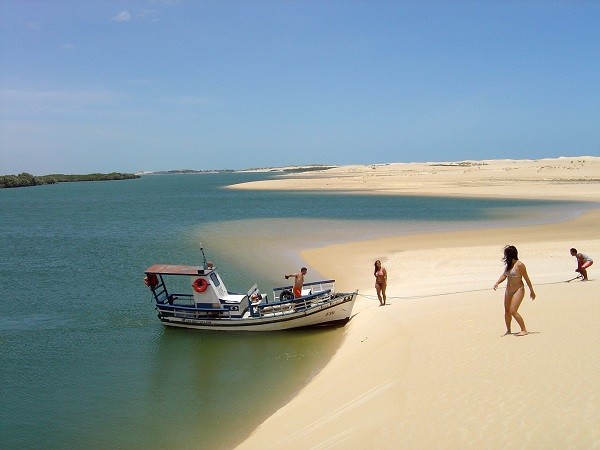Este post também está disponível em:
Português
English

Strong winds, sun, dunes, beaches, cliffs and the friendliness of the people of Rio Grande do Norte accompany visitors along the coast.
The history of Rio Grande do Norte begins just one year after the discovery of Brazil.
In 1501, the squadron of Gaspar Lemos touched the then coast of Touros (today the nice town of São Miguel do Gostoso) and there he planted the landmark of possession of the Portuguese Crown, the so-called Marco de Touros.
But the effective occupation of the region took almost a century, due to the resistance of the Potiguares Indians – “shrimp eaters” in Tupi – and French invasions.

With the help of men from Pernambuco and Paraíba, Portugal retook the land and, in 1598, began construction of the Forte dos Reis Magos.
The embryo of the city of Natal, the fortress was built to protect the main access to the lands of Natal: the Potengi River.
Well preserved to this day, the fortress is a pleasant visit when passing through the capital – both for its historical value and for the great viewpoint for the city’s landscape that emerges in front of a sunny and seductive coastline of white sands that fills the view, growing, to the west, in long strips towards the border with Ceará and, to the south, towards the lands of Paraíba.
Movable or fixed dunes of pink or beige tones, agitated or semi-deserted beaches, as well as the many lagoons complete the charming and varied range of natural beauties of the entire coast, which can be explored in pleasant buggy rides along the beach sand.

In the interior of the state of Rio Grande do Sul, the rich culture of the people who explored the arid territory has resisted the changes imposed by time, and the Portuguese influence and indigenous heritage are still preserved.
In small Acari, surrounded by mountains, you can go hiking and observe the unique landscape, which includes rock inscriptions.
The artisanship is also prominent in the interior, especially in Caicó.
Currais Novos, in turn, keeps the tradition of the quadrilhas festival during the June festivities.
See the tourist map of Rio Grande do Norte
Videos “Tourist spots of RN”
Get to know the tourist spots of RN, such as Apodi, Natal, Touros, São Miguel do Gostoso, Pipa, Timbau do Sul, Ponta Negra, Genipabu etc…


Guia de Turismo do RN

Polos e Pontos Turísticos do RN06:11

Praias e Lagoas do RN

7 Passeios Imperdíveis em NATAL e Região07:36

Principais Pontos de Turismo do RN

Roteiro de 6 dias em Natal e arredores08:32
TURISM HIGHLIGHTS OF RIO GRANDE DO NORTE
- The routes of architectural and cultural interest of Cidade Alta and Ribeira, in Natal.
- A journey through the life and work of folklorist, historian and ethnographer Luís da Câmara Cascudo, with a memorial and house in Natal.
- The beaches facing Ceará, among them Touros, São Miguel do Gostoso, Gatinhos and Ponta do Mel, reached on buggy rides.
- The pleasant and well-structured beaches of the south, such as those of Pipa, in the district of Tibau do Sul.
- The dams, the mountains, the festivals, the food and the archaeological sites of the sertão potiguar.
- Pipe village or Pipa beach is among the main attractions of RN
- Meet the best of the Northeast in the warm white sand waters of Natal
- Tourist Route along the north coast of RN – Genipabu, Gostoso and Touros
- Galinhos has natural beauties still little explored
- Maracajaú beach has water
- Transparent waters and coral reef
- São Miguel do Gostoso has beautiful beaches and sports
- Santa Rita de Cássia is the patron saint of the city of Santa Cruz in RN
- Barra do Cunhaú is a destination for those who enjoy extreme sports and nature
- Praias e Lagoas de Nísia Floresta RN
- The Seridó of RN has unique beauty of the semi-arid landscape and rich culture
- Fernando de Noronha has the largest concentration of dolphins on the planet
WHEN TO GO TO RIO GRANDE DO NORTE
For the beaches, at any time of the year. In summer (from December to February), the cities are crowded and prices go up.
In the months of June and July, to participate in the festivities of São João, in the Seridó region, enjoy the typical dances of the quadrilhas and taste the delicacies of the June festivities.
Rio Grande do Norte Tourism and Travel Guide
Rio Grande do Norte – History and Main Tourist Sites



















